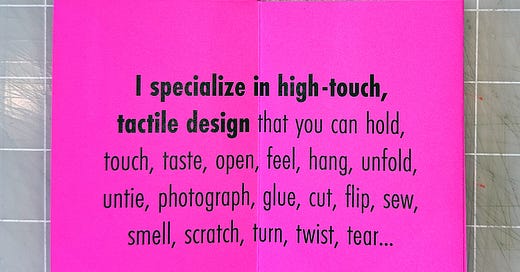MAKING
Even though I am a print designer, I was the living, breathing embodiment of the cobbler’s children have no shoes. Business cards may not be as essential as they once were—blame it on the pandemic, smartphones, or the general decline of stationery—but I missed having something tangible to hand to someone.
Not just any business card, though. I didn’t want a lame rectangle with my name, a trite title, and an email address. I wanted something that actually answered questions: What do you do? What have you been up to?
That’s hard to accomplish on a 3.5" × 2" double-sided piece of cardstock—no matter how well designed it is. So I turned to a simple, single-sheet zine format. When folded, it measures 2.25" × 4.25", but the genius is that you get eight panels to play with—way more space for storytelling, personality, and genuinely interesting information.
We experience much of life on our screens.
But our most memorable, human experiences can’t be found on phones, tablets and monitors. The most meaningful experiences happen beyond the glass…
I specialize in high-touch, tactile design that you can hold, touch, taste, open, feel, hang, unfold, untie, photograph, glue, cut, flip, sew, smell, scratch, turn, twist, tear…
Makeist: the intersection of ART + FOOD + DESIGN. Bespoke, limited edition books, zines, recipe collections, and artist catalogs. Every Sunday I share three things I am making, loving, and thinking about in my free weekly newsletter.
Zinestack: in an age of algorithms, ads and SEO, zines offer a tangible alternative. Whether you’re a creator, collector or curious, we’re here to inspire and connect. Discover zine makers and join a community celebrating zine culture and a do-it-yourself ethos.
Printed on Neenah Astrobrights Fireball Fuchsia 24lb Paper on a laser printer
LOVING
Too often, we convince ourselves that hosting requires perfection—a spotless house, an elaborate menu, everything just right. But Father Jack King offers a refreshing alternative: Scruffy hospitality—an approach that values connection over perfection, presence over polish:
“Scruffy hospitality means you’re not waiting for everything in your house to be in order before you host and serve friends in your home. Scruffy hospitality means you hunger more for good conversation and serving a simple meal of what you have, not what you don’t have. Scruffy hospitality means you’re more interested in quality conversation than the impression your home or lawn makes. If we only share meals with friends when we’re excellent, we aren’t truly sharing life together.”
Why Scruffy Hospitality Creates Space for Friendship by Father Jack King
THINKING
I published this in April of last year, and since then: (1) the discussion about the demise and fleeing of social media has only grown louder, (2) Ted Gioia wrote an article connecting dead malls to social media, and (3) Substack is emerging as the Tokyo of the internet. Here is my original post:
A few months ago, I updated my Instagram bio to read: I feed my creativity and cats, not the algorithm. Connect with me via the Makeist website and my free weekly newsletter.
I don’t really believe my small act of defiance will make a substantial difference—I am merely a single grain of sand on Zuck’s bunker beach in Hawaii. Yet, if enough of us unite, perhaps we can start to turn the tide. And by us, I don’t mean us oldsters. This isn’t about age; it’s not about shaking my GenX fist in technophobic TikTok frustration. By us, I mean the makers and creators—the artists, musicians, food bloggers, YouTubers, and TikTok influencers. Anyone who creates and shares content online. There’s a revolt brewing, and it’s gaining traction. It’s being talked about on Substack, during the keynote at SXSW 2024, on podcasts, in newsletters, and across social media.
In a recent podcast episode, Cal Newport discusses the growing frustration and revolt among artists: they’re leaving social media to reclaim control over their art and escape the pressures of algorithms.
He breaks down the difference between the current algorithm-driven model (Web 2.0) and the more collaborative, distributed trust model (the OG Internet) for sharing information and building a community online. Here’s how I think about the difference between the two models:
Journalist and author Derek Thompson once said, “If you go to Tokyo, you’ll find incredibly niche shops, like one that sells only 1970’s vinyl and 1980’s whiskey. This might be unthinkable in a Des Moines suburb, where businesses need to appeal to the mass market—like a Subway restaurant. But in Tokyo, with a potential market of 30-40 million people within a train ride, your niche shop can thrive because out of those millions, there are surely a few thousand who love 1970’s music and 1980’s whiskey. The Internet is like Tokyo in this sense—it allows you to be niche at scale.”
If the Internet (Web 1.0) is like Tokyo, allowing for a diverse range of niche shops, then Web 2.0—or social media platforms—are like shopping malls. The mall owners dictate who gets space and control which brands and products get sold. They favor sameness and prioritize what’s worked before. And they want to keep you inside their mall for as long as possible—they do not want you to leave and shop anywhere else.
As much as I am a child of the ’80s, I stepped out of the shopping mall when I created Makeist. The goal has always been to connect with my people—those who find my mashup of art, food, and design not just interesting, but inspiring and informative. Welcome to my little corner shop in the sprawling Tokyo of the internet.






Best thing to read first thing in the morning - I love these ideas and am going to shamelessly incorporate them.
Futura Condensed 💖